Do you know that the American invasion of Japan from 1945 to 1952 influenced today’s manga genre? This fact shows how Japanese anime and manga impact cultures worldwide deeply. They offer a unique look into Japanese life, showing its values, traditions, and challenges through engaging stories and art.
Anime and manga have reached far beyond Japan to captivate people everywhere. They help us understand Japan’s culture and how it has changed over time. This makes them a living reflection of Japan’s mix of tradition and the modern world.
Key Takeaways
- Anime and manga are profoundly influential cultural contributions from Japan.
- They offer a unique window into Japanese society, reflecting its values, traditions, and struggles.
- These audiovisual mediums have a global appeal, transcending barriers of language and culture.
- Anime and manga serve as a vibrant reflection of the duality between tradition and modernity in Japan.
- The American invasion of Japan in the mid-20th century played a significant role in shaping the modern manga genre.
The Origins of Anime and Manga
Today’s anime and manga have their roots in the 12th and 13th centuries. Yet, they really took off in Japan after World War II. American warships came to Japan in 1853, bringing Western comics and cartoons with them. These helped shape the start of manga as we know it today. Disney’s works were especially influential.
Influence of American Comics and Cartoons
America’s presence in Japan from 1945 to 1952 brought its comics and cartoons. This included Disney’s creations. The exposure to Western media had a major effect on Japan’s manga scene. It greatly influenced how manga started to evolve in Japan.
Evolution of Traditional Japanese Manga
The manga we know today was largely influenced by Osamu Tezuka’s work. Tezuka is called the “Father of Modern Manga.” His unique style, featuring big eyes, added a deep emotional layer to manga. This change helped manga grow in popularity all around the world.
Osamu Tezuka: The Father of Modern Manga
Osamu Tezuka is known as the Father of Modern Manga. He made big waves in manga after World War II, creating famous series like Astro Boy. Tezuka’s style and stories have influenced the manga industry for generations.
Anime and Manga as Windows into Japanese Culture
Anime and manga act like cool windows into Japanese culture. They show a lot about Japan’s traditions, daily life, and more. They cover things like food, language, architecture, and art. These shows and comics show how Japan deals with keeping its old ways while embracing new ones.
Exploring Diverse Cultural Elements
Anime and manga let us dive into Japan’s culture. They mix old traditions with fast changes happening worldwide. They show Japan in many lights, from its rich past to its cutting-edge present.
Navigating Tradition and Modernity
The clash of old and new is a key theme in anime and manga. They pit the technology of places like Tokyo against the ancient beauty of areas like Kyoto. This shows the blend of old and new that defines Japan today.
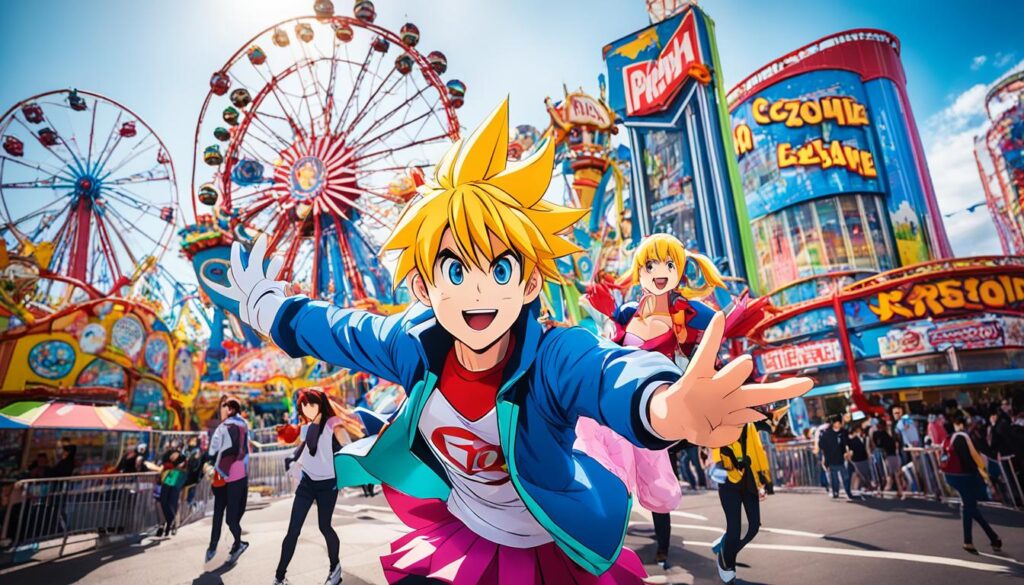
Narratives and Aesthetics: The Essence of Anime
Anime is unique because of its rich stories and beautiful art. Unlike Western cartoons, anime shows a more complex view of stories. It focuses on characters and their evolving relationships. These characters feel real because they have strong personalities. Their lives play out in interesting ways, making stories stand out.
The drawing style of anime is also special. It looks more like a visual novel than normal cartoons. You can tell something is anime by its bright colors and unique character designs. Characters often have big, expressive eyes and slim bodies. The way anime shows movement is also beautiful. All these elements draw people in, making anime loved around the world.
Reflection of Society in Anime
Anime reflects Japan’s societal norms, values, and struggles. It often uses fantastical or futuristic settings to address real-world issues. Series like Welcome to NHK explore social isolation and the challenges young adults face.
Work Culture and Family Dynamics
Anime deep dives into Japan’s work culture, focusing on hierarchy and separating work and personal life. Chihiro’s Journey and Evangelion discuss the country’s changing identity. They look at generational gaps and societal pressure, showing how they impact people in Japan.
Generational Gaps and Societal Pressures
Anime discusses generational gaps and societal issues in a nuanced way. It looks at tradition versus modernity, giving insight into the Japanese struggle with identity and cultural change.
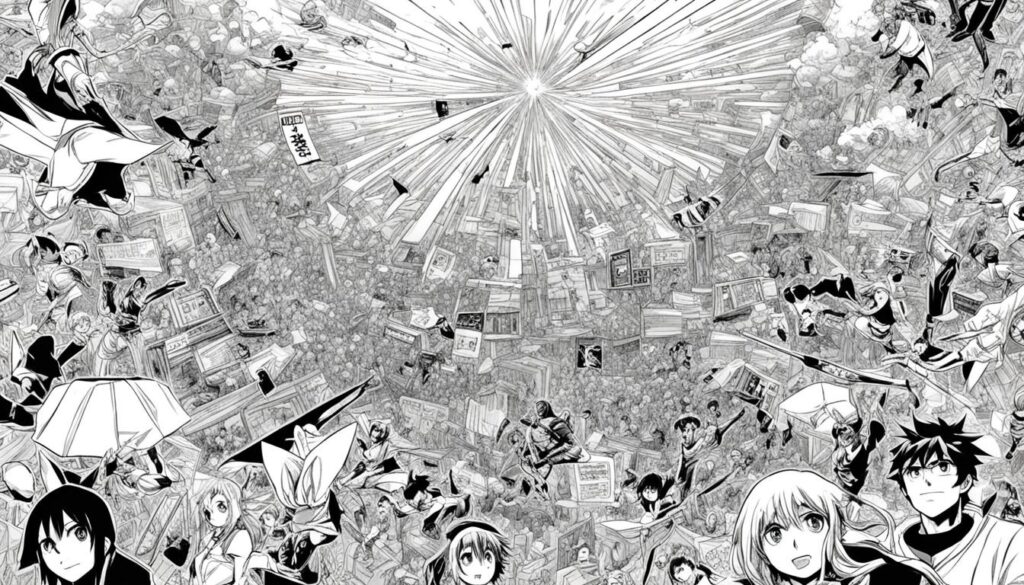
Preserving Traditional Folklore and Mythology
Anime and manga help keep Japan’s traditional folklore and mythology alive. They bring to life diverse yokai (mythological beings) and characters from old Japanese stories. For example, the Naruto series features heroes from a classic novel called Jiraiya Goketsu Monogatari.
Their stories add a magical layer to anime and manga, showing the rich and unique side of Japan’s culture. This way, they introduce people to Japan’s deep cultural history.
These traditional tales make anime and manga even more special. They help keep Japan’s ancient traditions and stories loved and remembered. Through anime and manga, Japan’s live and bright culture is shared, making these tales stay important and loved by everyone.
Portrayal of Japanese Religion and Customs
Anime and manga often show elements of Japanese religion and customs. This is true, even with Japan’s move towards varied beliefs today. Shinto and Buddhism play big roles. You see temples, special events, and gods like dôsojin (protecting travelers and roads).
Shinto and Buddhist Influences
These traditions are alive, even in modern or future anime and manga. They show how old beliefs and practices still matter in Japan. These shows let us see how deep traditions are in Japan, even with all its changes.
Festivals and Ceremonies
Anime and manga highlight Japan’s lively festivals and ceremonies. They include New Year’s traditions and the O-Bon festival for family and ancestors. Shows also include kids’ celebrations at ages three, five, and seven.
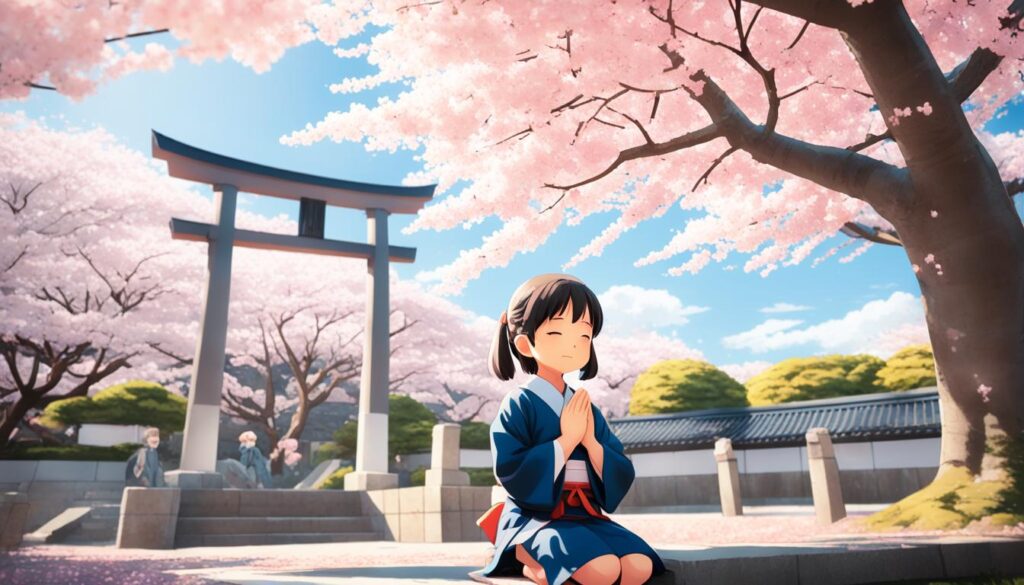
Historical Representations and Aesthetics
Anime and manga get a lot from Japan’s historical legacy. They mix in samurai culture and feudal era aesthetics. This includes showing samurai and talking about the samurai code of conduct (Bushido).
These shows and comics let us see into Japan’s history. They show us traditional styles and what life was like back then. This makes the stories feel real and teaches us about Japan’s past.
Samurai Culture and Bushido
Anime and manga love to dig into samurai culture. They focus on how samurai lived by a strict code (Bushido). This code was about honor and moral values.
Studying the Bushido helps us understand the samurai’s mindset. It shows how respected they were in Japan. Their way of life is admired and remembered through these stories.
Feudal Era Aesthetics
Anime and manga also respect the feudal era’s aesthetics. They use old styles and clothes to create a feeling of the past. Even in modern or future settings, these elements are used.
By using these feudal aesthetics, the stories connect to Japan’s history. Viewers learn about the country’s past and its effects today. This deepens our respect and understanding of Japan’s cultural history.
The Duality of Tradition and Modernity
Anime and manga showcase Japan’s blend of tradition and modern life. They dive into how old ways mix with new trends. This mix creates both conflict and growth in Japan’s cultural identity.
Cultural Clashes and Identity Evolution
Anime stories often show the mix of Japan’s fast-paced cities with its historical countryside. Places like Tokyo’s high-tech center and Kyoto’s traditional beauty are compared. These comparisons show how Japan balances its history with new changes.
Urban and Rural Landscapes
Anime and manga offer a deep look into Japan’s rich culture. They highlight how Japan both values its past and looks towards the future. This helps viewers understand the complexity of Japan’s cultural journey.

The Universal Appeal of Anime
Anime originally comes from Japan. But its unique style has captured the hearts of people all over the world. No matter where you come from, you’ll find something you love in anime. Its ability to tell many types of stories has drawn in people from all walks of life. This shows how anime is like a cultural ambassador around the globe.
Exploring science fiction, fantasy, and issues we face today, anime tells many stories. It helps us understand Japan and its people better too. People from all over can connect through the many stories anime tells. This makes anime an important part of entertainment and art worldwide.
Transcending Barriers of Language and Culture
Anime’s cross-cultural appeal breaks through its Japanese roots and speaks to everyone. Its wide range of stories and characters appeal to viewers worldwide. Anime brings us all together by sharing its unique style and tales. It truly bridges gaps and helps us understand Japan’s rich culture.
Reflection
Anime as a Lens into Japanese Society
Anime and manga open up unique views into Japanese life for people around the world. They highlight how Japan’s traditions mix with new trends, showing cultural tensions and identity crises that define the country.
Navigating Cultural Tensions and Identity
These shows and comics look at important topics like daily life, work, family, and different age groups. They offer many angles on Japan today. By using stories and art, they show how Japan finds a balance between its past and the changing world.
Through anime and manga, we get insights into Japanese thoughts, making them key in understanding the nation’s complex society.
The Global Impact of Anime and Manga
Anime and manga have grown beyond Japan, influencing the world in a big way. Shows and comics like Pokémon, Sailor Moon, Dragon Ball Z, and Evangelion are now loved everywhere. They connect with people from all over, breaking cultural borders.
Their stories, looks, and messages make them widely loved. They’ve helped interest people in Japan’s culture and sparked global conversations. This has made them more than just entertainment. They are now key players in how the world sees Japan.
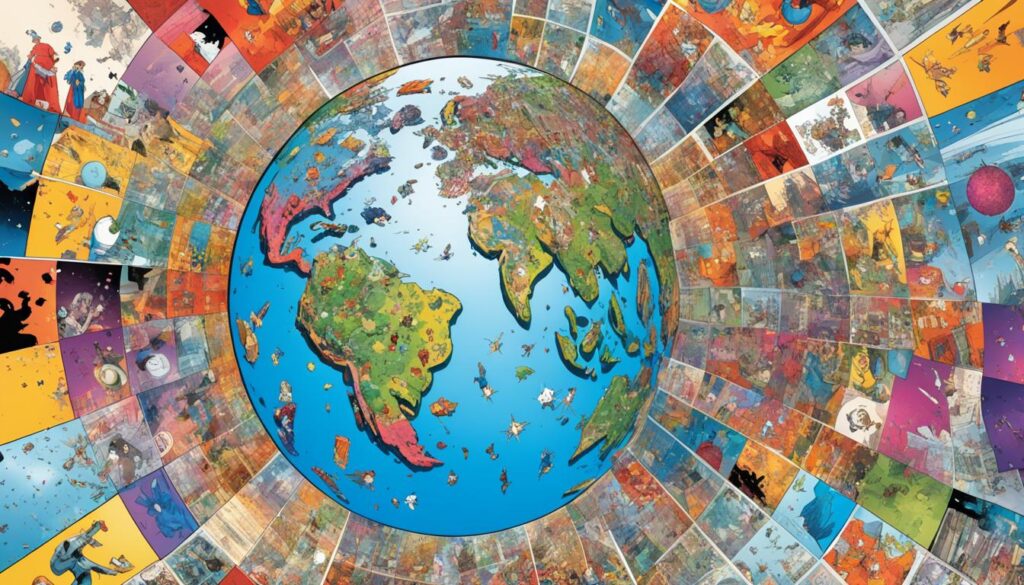
Character Design and Artistic Expressions
Anime and manga are loved for their unique artwork. Their characters can look a bit strange, with big eyes and slender bodies. But, these features make them stand out and show the style of the artform.
Anatomically Implausible yet Captivating
Anime and manga characters aim to be unforgettable, rather than realistic. Their exaggerated features, like big eyes, add charm. This choice makes them more expressive, letting their emotions and personalities shine through.
Vibrant Color Palettes and Visual Storytelling
Colors in anime and manga are bright and bold. They help tell the story and draw viewers in. This mix of art and story is key to their global success.
The mix of art, story, and unique characters in anime and manga draws people in. It shows the genres’ lasting appeal and deep cultural influence.
Positive Messages and Morals in Anime
Anime often shares positive messages and moral lessons. It highlights themes of resilience, perseverance, and the power of determination. The idea of “Faito” (fight) is big in well-known anime like Saint Seiya and Dragon Ball Z. It shows that those with a pure heart and strong will can beat any obstacle.
The Concept of “Faito” (Fight)
These stories teach about the value of perseverance. They say that with a lot of effort and staying true to your goals, you can win over tough situations. Anime isn’t just for fun; it also gives hope and belief in our human spirit’s power to change things.
Perseverance and Determination
Anime shows us heroes who never give up. Characters in shows like Naruto, Fairy Tail, and One Piece are great examples. Naruto wants to be the Hokage, Natsu from Fairy Tail seeks his father, and Luffy from One Piece aims to be the Pirate King. They all teach us to keep dreaming and to tackle problems without fear.
Anime tells us about the power of perseverance and determination. It wants us to learn from these stories and feel stronger. The message is clear: with effort and staying true to our goals, we can beat anything. It’s about believing in ourselves.
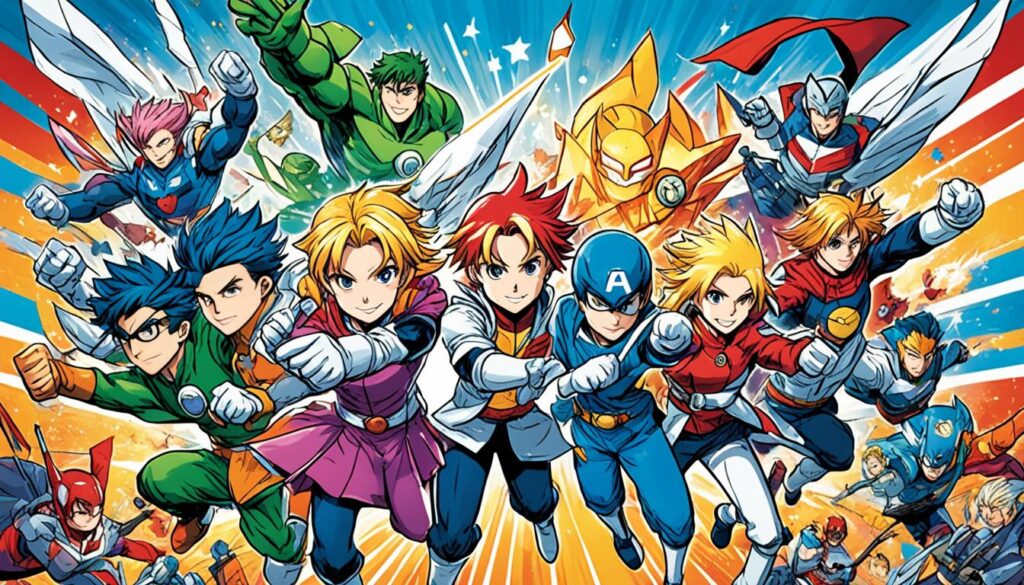
Iconic Anime Series and Their Cultural Significance
Anime has brought us many famous series. These shows not only reach people worldwide but are also deeply significant in Japan’s culture.
Astro Boy is a key example. It was made by the talented Osamu Tezuka. He is considered a leader in manga and anime creation.
Astro Boy’s story is about a robot trying to help the Earth. This message was powerful after World War II. It showed hopes for the future and started many discussions about technology and the universe.
Astro Boy and the Birth of Anime
Astro Boy made a big impact on anime. It reached people in a special way. They saw their own fears and dreams in the stories.
This made it very important in the history of anime. Many believe it’s one of the most important series ever.
Dragon Ball Z and Saint Seiya: Embodying “Faito”
Shows like Dragon Ball Z and Saint Seiya have also become huge. They teach us about fighting against all odds.
The characters in these series show great strength, courage, and the will to win. They have inspired many people around the world.
They are not only fun but also a key part of Japanese culture. Their impact is long-lasting, making them heroes in the world of anime and storytelling.
Conclusion
Anime and manga have become ways to peek into Japanese life. They show the country’s culture, changes over time, and how people interact. They are now loved worldwide for their stories, art, and messages.
These works keep old tales alive and share Japan’s mix of old and new. They help people understand Japan better. They also bring different cultures together. Anime and manga are key parts of Japan’s cultural history. And they continue to shine on the global stage.
In closing, anime and manga are more than just stories. They are mirrors into Japanese culture. They connect people from all over the world. These art forms show Japan’s unique identity and its ongoing evolution.
FAQ
What is the significance of anime and manga in reflecting Japanese society?
Anime and manga are like special windows. They show us Japan’s rich culture in exciting ways. They blend old traditions with new ideas, showing Japan’s modern life. These stories reflect what Japan is all about today.
How do the origins of anime and manga trace back to Western influences?
In 1853, American ships introduced Japan to Western cartoons. This included Disney works, which started a big trend. Osamu Tezuka, known as the “Father of Modern Manga,” helped mix traditional manga with Western styles.
What cultural elements do anime and manga incorporate to showcase Japanese identity?
Anime and manga show a lot about Japan, like its food, art, and festivals. They also share beliefs and stories from Japan’s past. This makes these stories a treasure for keeping Japan’s culture alive.
What are the distinctive narrative and aesthetic features of anime that contribute to its global appeal?
Anime tells stories in unique ways, with deep characters and bright visuals. These features make it loved worldwide. The colorful art, big eyes, and stylish characters are recognizable to fans everywhere.
How do anime narratives reflect the societal norms, values, and struggles within Japan?
Anime often looks at real issues in Japan, like fitting into society and finding work. It also shows the stress young people face in school and relationships. These stories help everyone understand life in Japan.
What role do Japanese religion and customs play in the narratives and aesthetics of anime and manga?
Anime and manga use Japan’s religious and cultural background a lot. Elements like shrines and festivals are common. They add depth to the stories, showing how tradition is still important today.
How do anime and manga portray the historical legacy and aesthetic influences of Japan’s feudal era?
Anime and manga often highlight Japan’s past, such as samurai and old-style buildings. They explore Bushido, the samurai code, too. This gives fans a glimpse into Japan’s rich history.
How do anime and manga reflect the duality between tradition and modernity in contemporary Japan?
Anime shows both the modern and traditional sides of Japan. It contrasts cities full of technology with rural areas that feel old. This contrast tells stories about Japan’s often delicate mix of old and new.
What factors contribute to the universal appeal of anime across global audiences?
Anime is loved worldwide because it tells diverse stories that anyone can relate to. It doesn’t matter where you’re from. Its themes and genres bring people together, exploring the many faces of Japan.
How do iconic anime series reflect the cultural significance and impact of the medium?
Shows like Astro Boy, Dragon Ball Z, and Saint Seiya are beloved classics. They’ve entertained many and helped spread Japan’s culture worldwide. They are shining examples of Japan’s creative storytelling.
Source Links
- https://anamaturewriter.medium.com/does-anime-truly-reflect-japanese-society-1597e1e3035b
- https://moreby.us/anime-a-reflection-of-japanese-culture/
- https://community.wacom.com/en-us/history-of-manga/
- https://japan-avenue.com/blogs/japan/history-of-manga
- https://riverjournalonline.com/around-town/arts-culture/anime-a-reflection-of-japanese-culture/116389/
- https://medium.com/@masha_hauteart/exploring-the-cross-cultural-exchange-of-anime-in-european-art-9a29a84a31e3
- https://core.ac.uk/download/pdf/1322156.pdf
- https://www.nationalgeographic.org/article/storytelling-and-cultural-traditions/
- https://www.britannica.com/topic/Shinto
- https://www.insidejapantours.com/japanese-culture/religion/
- https://culturalatlas.sbs.com.au/japanese-culture/japanese-culture-core-concepts
- https://www.britannica.com/topic/philosophy-of-art/Analysis-of-representation
- https://www.theartstory.org/movement/aesthetic-art/
- https://quod.lib.umich.edu/j/jii/4750978.0004.306/–aesthetic-reflection-and-the-colonial-event-the-work-of-art?rgn=main;view=fulltext
- https://repositorio.comillas.edu/jspui/bitstream/11531/22263/1/TFG Vacas de Bruchard, Juan.pdf
- https://kathmandupost.com/books/2023/10/28/exploring-the-duality-of-tradition-and-modernity
- https://www.tate.org.uk/research/tate-papers/21/somewhere-and-nowhere-between-modernity-and-tradition-towards-a-critique-of-international-and-indigenous-perspectives-on-the-significance-of-contemporary-chinese-art
- https://newculturalanalyst.wordpress.com/2015/04/09/the-appeal-of-japanese-anime/
- https://medium.com/@giacco.danielle/anime-and-identity-how-conventions-shape-and-reflect-fan-identities-3c2c84ce7435
- https://letstalkscience.ca/educational-resources/backgrounders/reflection-and-refraction
- https://www.britannica.com/science/light/Reflection-and-refraction
- https://www.sciencelearn.org.nz/resources/48-reflection-of-light
- https://www.linkedin.com/pulse/cultural-significance-anime-dayananda-sagar-university-scms-pg-vh06c
- https://medium.com/@Junaidchandio35/exploring-the-cultural-impact-of-anime-how-japanese-art-form-showcases-incredible-japanese-culture-e97d95295002
- https://www.linearity.io/blog/character-design/
- http://sevencamels.blogspot.com/2009/08/confessions-of-lazy-character-designer.html
- https://blog.displate.com/anime-quotes/
- https://www.linearity.io/blog/anime-quotes/
- https://www.cbr.com/greatest-anime-based-on-real-history/
- https://movieweb.com/most-popular-anime-of-all-time/
- https://www.rhulisc.com/blog/how-to-write-a-reflection-paper
- https://libguides.usc.edu/writingguide/assignments/reflectionpaper
- https://writingcenter.unc.edu/tips-and-tools/conclusions/
